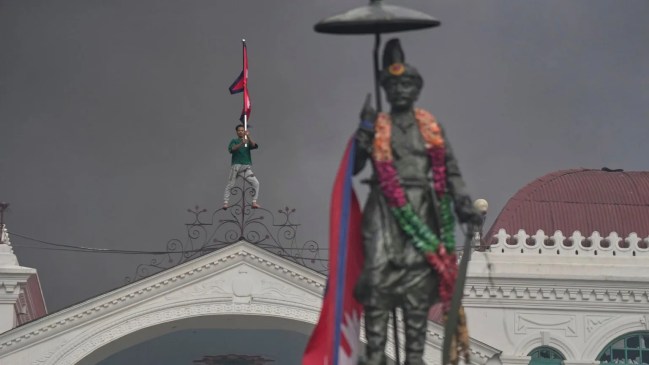Opinion Nepal’s political class is paying the price for its insensitivity to aspirations of the youth
The ‘Gen-Z’ do not look politically aligned, but they have a lot of affinity with the new political forces and independent leaders like Kathmandu Mayor, Balen Sah. But can they promise stability?
 The future of Nepal's politics looks very bleak. With the old political parties gone, at least for now, and rise of an amorphous political mass, government formation could be difficult (AP Photo/Niranjan Shrestha)
The future of Nepal's politics looks very bleak. With the old political parties gone, at least for now, and rise of an amorphous political mass, government formation could be difficult (AP Photo/Niranjan Shrestha) Written by Chandra Dev Bhatta
Nepal is in political turmoil. Protests, largely by Gen-Z, began on Monday. In less than 40 hours, the protesters have brought down not only the coalition government of the two largest parties, Nepal Congress (NC) and Communist Party of Nepal United Marxist Leninist (CPN-UML), but also jolted the country’s political class. The top leaders who have played a crucial role in the country’s journey towards democratisation have been assaulted and their houses burnt. The Prime Minister of the coalition government, K P Sharma Oli, has resigned, and his whereabouts are unknown. The President of Nepali Congress, the second oldest party in the region (after Indian National Congress), and five-time Prime Minister, Sher Bahadur Deuba and his Arzu Rana Deuba (the foreign minister) were publicly beaten and handed over to the security personnel. The protesters have burnt administrative complexes in Kathmandu. Several buildings outside the capital have also been reduced to rubble.
What led to this state of affairs in a country which was in the midst of democratic consolidation after the promulgation of its seventh constitution in 70 years in 2015. Many had believed that with a new political dispensation in place, after the promulgation of the new constitution, Nepal would enter an era of peace and stability. But that did not happen. Nepal has been ruled by more than 10 governments in 10 years. The changes, though, were very cosmetic because political power kept rotating among the same leaders. That has actually been the bane of politics in Nepal. A handful of people have held sway in the country for more than 35 years. The youth have been the biggest victims of this “recycling” of political leaders.
Posts of judges, diplomats, and even academics in universities and other public institutions were rationed among loyalists of political parties. The economy has been completely captured by the elites. Those who are not affiliated with political parties have been left in the lurch. The last resort for survival was “employment” in West Asian countries, India and other parts of the world. Nepal’s economy failed to produce employment for its youth. Today, more than 25 per cent of the national GDP is built on remittances. Yet, the political class found nothing that they had to correct.
Nearly half of the country’s nearly three million population were, in one way or the other, affiliated to a political party. Those affiliated with political parties wanted to maintain the status quo. The protests express the anger of those left behind. Every political change alienated certain groups of people from the state and society in one way or the other. Corruption became endemic to Nepal, and reached a point where the country was in danger of being blacklisted by the FATF. By and large, Nepal’s old political parties failed to read the societal dynamics, let alone fulfil the aspirations of the people. The vacuum was filled with new political parties and independent candidates. They have been challenging the political ecosystem of the old parties since the last general elections in 2022. The ‘Gen-Z’ do not look politically aligned, but they have lot of affinity with the new political forces and independent leaders like Kathmandu Mayor, Balen Sah.
The Oli government’s ban on social media angered the youth. Whether Oli failed to understand the changing political dynamics in the region, especially the reasons that hastened the downfall of several regimes in South Asia, or if he became a pawn in broader geopolitical rivalry is something that’s not yet clear. What can be said with some certainty, for now, is that Nepal has always been vulnerable to geopolitical pressure. This demanded navigating the region’s turbulent political waters in a practical way. But that imperative was lost on Nepal’s leadership. As a result, the country has lost out on the geopolitical and economic front in recent years. The current turmoil could have been averted had Oli and his coalition partners worked sanely.
The future of Nepal’s politics looks very bleak. With the old political parties gone, at least for now, and rise of an amorphous political mass, government formation could be difficult. The new political forces might have “political legitimacy” but lack “legal-rational” legitimacy. Constitutional issues might arise when an interim government takes over. But the fact also is that “doctrine of necessity” or Apad Dharma, mentioned in the Mahabharata, will need to be taken into consideration. The Army is sure to play an important role in constituting the transitional government.
Like other recent movements in South Asia, Nepal’s Gen-Z movement is headless. Often, such movements are hijacked by multiple actors (both internal and external) who want to fish in the troubled water. The politics of revenge and self-aggrandisement may become normal practice in the days to come, and if it continues for a longer time, sadly enough, this would push Nepal towards more turmoil.
The writer is a Kathmandu-based political scientist




